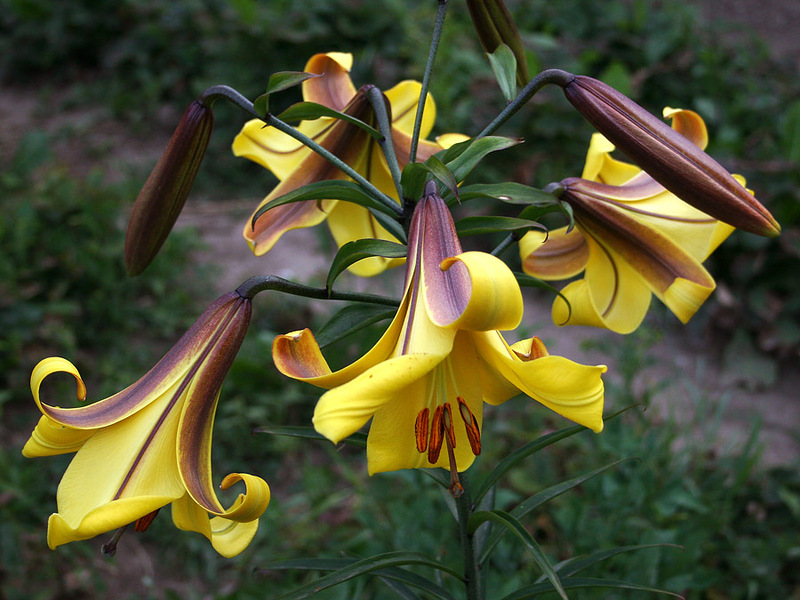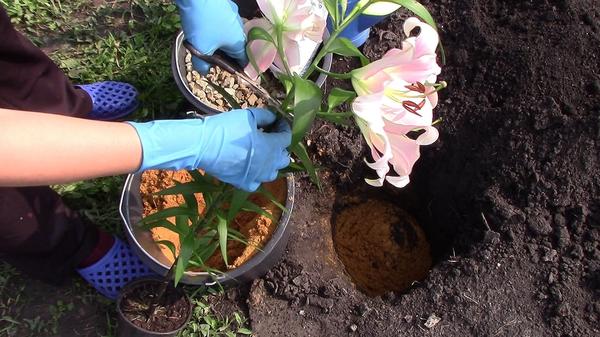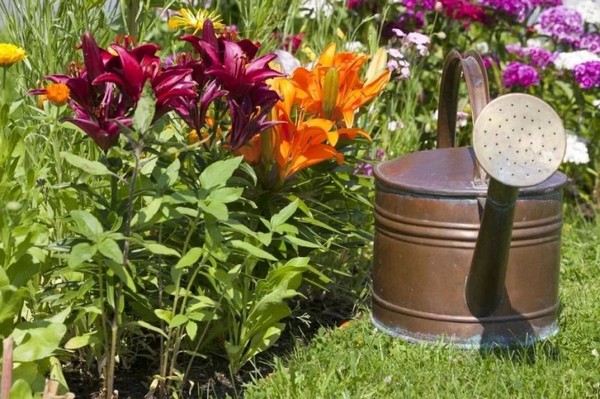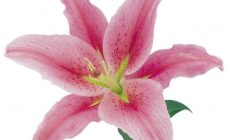Content:
Tubular lilies are one of the representatives of the Liliaceae family with buds resembling a horn in shape. The following will be a detailed description of these plants and their subspecies.
History
The first mention of the tubular lily was recorded at the dawn of the twentieth century in the DPRK. The natural habitat was considered to be places with rocky soil, which are comfortable conditions for the growth of low-growing shrubs, where in 1903 they were discovered by the botanist from Great Britain Ernest Henry Wilson.
Lily white tubular, or royal, is considered a symbol of the revival of breeding work for the development of new varieties.
Characteristics of varieties
| Part / type name | Lily gramophone | Lilies of the White Planets | White Lily |
|---|---|---|---|
| Stem | Slim and strong, dark green in color, reaching a height of 120 cm. | Straight, solid, dark green or polyton: green with brown stripes. It grows up to 1 m 30 cm. | Straight and thin dark green color. It grows up to 1 m 50 cm. |
| Sheet | Light green in color. It has the shape of a cone and occupies a "sitting" position on the trunk. The upper rows are evenly spaced along the entire length of the stem, the lower ones are grouped in whorls and represent the "scarf" of the plant. | It has the shape of a cone, 20 cm long, with a slightly curved end downward. The color is light green. They "sit" on the barrel in a checkerboard pattern. At the base of the leaf, seed pods are formed, used in reproduction. | It is a light green cone with a wide base and tapered end. The front side is glossy, the back side tends to a matte shade. |
| The deciduous mass is grouped into whorls that completely cover the flower stem. | |||
| Flower | The buds have 6 petals, extended downwards and slightly curved at the ends. The color ranges from white to lilac. The stamens and pistil are greenish-orange, where the bases are colored in the first color, and the tips in the second. The number of flowers varies from 5 to 20 per stem. | White Planet lily tubes range in color from white to yellow. Occasionally there are multi-colored blotches. In a diameter, a large flower is 25 cm. On the stem, from 1 to 10 flowers are read, collected in a brush in the form of a pyramid. | The tube (about 8 per stem) is medium in size, up to 20 cm, with 6 snow-white petals, painted in a yellowish tint at the base. Stamens are greenish-orange. |
| Flowers are lowered down and to the sides. The color is exclusively white. | |||
| Bloom | The blooming period of flowers falls on 7, 8 months of the year. The buds bloom in turn during flowering. Each flower retains its color for 7 days. | It picks up paints and keeps them during the 2nd month of summer. In comfortable conditions (sunny places of the site or a slightly darkened "house") it gives a pleasant aroma and pleases with abundant flowering. | The blooming period of the flower occurs in mid-summer and lasts until the beginning of autumn. |
Agrotechnics
Reproduction
The cultivation of varietal lilies is carried out in the following ways.
Bulbous
Healthy bulbs should be selected and disinfected. After complete preparation of the planting material, put it in a pre-prepared hole and pour water at room temperature, it is advisable to defend it in advance.After passing all the classical planting procedures, wait for shoots and feed them once a year.
Seminal
To carry out reproduction with this option, you need:
- collect boxes of seeds or bulbs after flowering lilies;
- take out the seeds and put them in warm water for 3-4 hours to swell;
- keep the temperature in the room at least 18 ° C;
- plant seeds in different containers or in one, but keeping the distance between seedlings 15 cm.
- sprinkle with earth;
- water every day, but do not pour;
- after watering, loosen the soil.
Plant preparation
Before planting a flower, you must:
- choose a material - the bulb must be healthy, without dents and damage, firm and large;
- process it with a solution of potassium permanganate for disinfection;
- keep in hot water for several hours - accelerates germination;
- straighten the root system;
- prepare for transportation by planting in vermiculite or very light soil, reducing the risk of damage to the root.
Site preparation
To "populate" the lily in a new "house" it is desirable:
- choose a plot of land on the sunny side;
- prepare a soil from sand and limestone;
- make the soil "fresh" by using ash;
- build a garden bed in the form of a slide and dig a hole, 35 cm deep, at its top;
- Cook the next hole at a distance of 15 cm from the previous one.
Disembarkation
You can plant or transplant a flower in different conditions:
- In open ground.
To carry out the procedure, it is advisable to observe the following steps:
- wait for autumn - temperatures are not lower than 15 degrees;
- pour the prepared soil to the bottom of the dug hole;
- make the working depth 3 times the size of the bulb;
- put the cooked onion in the hole and sprinkle with earth, equalizing the planting site;
- water abundantly and insulate with dry grass and leaves.
- Into a home pot.
When disembarking you need:
- choose a large pot for a tubular flower, but you should pay attention to the fact that mineral and vitamin substances are readily available for the root system;
- keep away from the batteries, but closer to the windows, since the representative of the flora loves sunlight and will thank you with abundant flowering;
- keep the temperature up to 28 ° C during the germination of the bulb;
- monitor the optimum humidity.
Care
To get a good, healthy shrub, you should take care of it by following these guidelines:
- make timely nitrogenous feeding every spring;
- loosen the soil after watering;
- remove weeds and debris from the planting site;
- do not plant other flowers near the tubular representative of Liliaceae.
- water sparingly, making sure that no water remains on the surface of the earth;
- remove seed pods after the end of the flowering period;
- Cover the ground around the tubular flower with straw or hay to reduce the risk of weeds.
Disease prevention
Tubular lilies are susceptible to attack by the following pests:
- tick;
- flies;
- mealy worm.
To reduce the risk of these parasites, you must:
- monitor air humidity;
- arrange a "shower" using a spray bottle;
- spray with a solution of potassium permanganate once a month.
Preparing for winter
In order for the plant to survive the winter cold well, it is desirable:
- wait until the flower fades, dries in the sun and is ready for hibernation;
- cut off most of the stem;
- cover with straw and dry grass.
Application
The flowers of the described representative of the Liliaceae family are used in the following areas:
- medicine - for the treatment of burns, wounds, gastrointestinal tract;
- floristry - they betray a special chic and gracefulness to the giants with whom they are combined.
Cons and pros of a flower
Among the advantages of the tubular lily of the varieties discussed above, it is worth noting:
- strong immunity;
- high frost resistance only in adult plants;
- high adaptive qualities;
- ease of reproduction.
The disadvantages include:
- low frost resistance;
- the need to shelter or dig up young seedlings for the winter.
Summing up, it is worth noting that the main features of the tubular lily and its varieties are described in detail, by which you can easily distinguish the considered species from other representatives of Liliaceae.
















